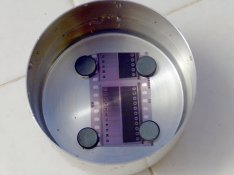albada
Subscriber
Although I've been quiet for weeks, I've still been busy trying to create a concentrated version of XTOL that will keep for years. I think I'm close. Below is the graph of true XTOL versus my test-dev (TMY2, 6.5 min at 20C):

As you can see, the two curves are so close that they appear to be one curve in the thumbnail. And careful exam in my 22X loupes shows the grain is the same too. Here's the formula:
So far, I've tested this by mixing the ingredients directly into water; I haven't actually made any concentrate yet. That's the next step.
Chemists will be interested in the latest weird problem I had:
Adding the propylene glycol to that developer drops the pH by .07 and raises the temperature by 1 degree C. So it appears to react with something. Adding PG to XTOL does not change its pH, and the only thing my dev has that XTOL lacks is ascorbic acid, so I'm guessing that AA reacts with PG. The dev works fine anyway, but I had to remove a little acid and add a little alkali to correct the pH. PG is not as inert as I thought. Do the chemists here have any idea what's happening?
Mark Overton

As you can see, the two curves are so close that they appear to be one curve in the thumbnail. And careful exam in my 22X loupes shows the grain is the same too. Here's the formula:
Propylene glycol .................... 24 ml
Sodium metaborate 4 mol ..... 6.7 g
Ascorbic acid ......................... 8.5 g
DimezoneS/Phenidone .......... 0.2 / 0.105 g
Propylene glycol to ................ 33.3 ml (final volume)
(heat to 90C to dissolve everything and drive out the water in the metaborate)
To make one litre of developer, mix 33.3 ml of concentrate into water containing 90 grams of sodium sulfite. That's 1+29 dilution.
Sodium metaborate 4 mol ..... 6.7 g
Ascorbic acid ......................... 8.5 g
DimezoneS/Phenidone .......... 0.2 / 0.105 g
Propylene glycol to ................ 33.3 ml (final volume)
(heat to 90C to dissolve everything and drive out the water in the metaborate)
To make one litre of developer, mix 33.3 ml of concentrate into water containing 90 grams of sodium sulfite. That's 1+29 dilution.
So far, I've tested this by mixing the ingredients directly into water; I haven't actually made any concentrate yet. That's the next step.
Chemists will be interested in the latest weird problem I had:
Adding the propylene glycol to that developer drops the pH by .07 and raises the temperature by 1 degree C. So it appears to react with something. Adding PG to XTOL does not change its pH, and the only thing my dev has that XTOL lacks is ascorbic acid, so I'm guessing that AA reacts with PG. The dev works fine anyway, but I had to remove a little acid and add a little alkali to correct the pH. PG is not as inert as I thought. Do the chemists here have any idea what's happening?
Mark Overton












